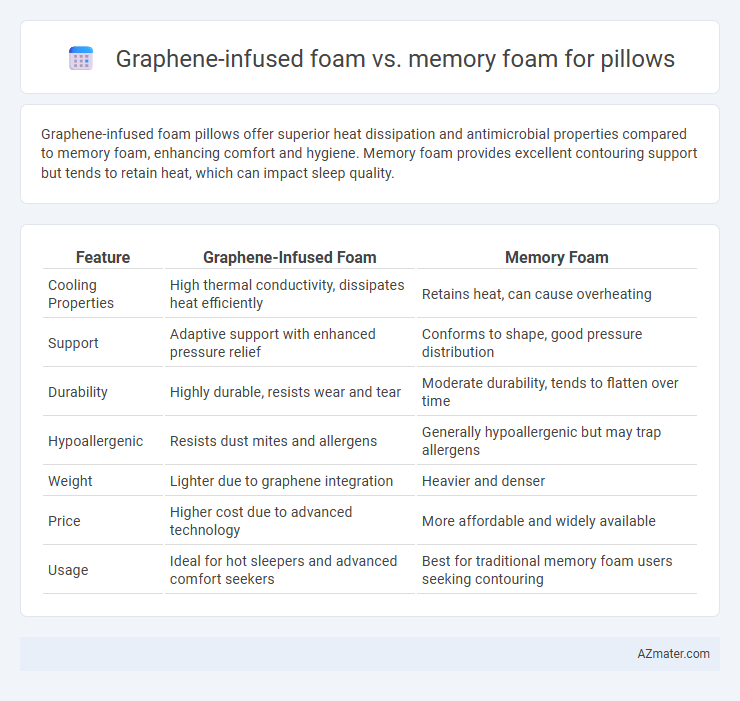Graphene-infused foam pillows offer superior heat dissipation and antimicrobial properties compared to memory foam, enhancing comfort and hygiene. Memory foam provides excellent contouring support but tends to retain heat, which can impact sleep quality.
Table of Comparison
| Feature | Graphene-Infused Foam | Memory Foam |
|---|---|---|
| Cooling Properties | High thermal conductivity, dissipates heat efficiently | Retains heat, can cause overheating |
| Support | Adaptive support with enhanced pressure relief | Conforms to shape, good pressure distribution |
| Durability | Highly durable, resists wear and tear | Moderate durability, tends to flatten over time |
| Hypoallergenic | Resists dust mites and allergens | Generally hypoallergenic but may trap allergens |
| Weight | Lighter due to graphene integration | Heavier and denser |
| Price | Higher cost due to advanced technology | More affordable and widely available |
| Usage | Ideal for hot sleepers and advanced comfort seekers | Best for traditional memory foam users seeking contouring |
Introduction to Advanced Pillow Materials
Graphene-infused foam pillows integrate graphene's exceptional thermal conductivity and antibacterial properties, enhancing breathability and hygiene compared to traditional memory foam. Memory foam contours effectively to the head and neck, providing personalized support by responding to body heat and pressure points. Advanced pillow materials like graphene foam improve sleep quality by combining temperature regulation and durability, outperforming conventional memory foam in both comfort and functional longevity.
What Is Memory Foam?
Memory foam is a viscoelastic material made from polyurethane with added chemicals to increase its viscosity and density, providing superior comfort and support by contouring to the body's shape and evenly distributing weight. Unlike traditional foam, memory foam reduces pressure points and limits motion transfer, making it ideal for pillows to enhance sleep quality and spinal alignment. Graphene-infused foam incorporates graphene particles to improve heat conductivity and durability, offering a cooler and more breathable alternative to conventional memory foam pillows.
What Is Graphene-Infused Foam?
Graphene-infused foam incorporates graphene particles into traditional foam, enhancing thermal conductivity and durability compared to memory foam. This innovation allows pillows to dissipate heat more efficiently, providing a cooler sleep surface and improved pressure relief. As a result, graphene-infused foam pillows offer superior temperature regulation and resilience, making them an advanced alternative to conventional memory foam options.
Comparison of Comfort and Support
Graphene-infused foam pillows offer superior cooling properties and enhanced breathability compared to traditional memory foam, promoting a more comfortable sleep by dissipating heat efficiently. Memory foam provides excellent contouring support by molding to the head and neck, but often retains heat, potentially causing discomfort during extended use. Graphene-infused foam maintains the supportive qualities of memory foam while improving thermal regulation and durability, making it a preferred option for users seeking balanced comfort and consistent support.
Temperature Regulation and Breathability
Graphene-infused foam pillows outperform traditional memory foam in temperature regulation due to graphene's exceptional thermal conductivity, which disperses heat efficiently and maintains a cooler sleeping surface. This advanced material enhances breathability by promoting better airflow within the foam structure, reducing moisture buildup and preventing overheating. Memory foam tends to retain body heat and restrict airflow, making graphene-infused foam a superior choice for users seeking a cooler, more breathable pillow for improved sleep comfort.
Durability and Longevity
Graphene-infused foam pillows exhibit superior durability compared to traditional memory foam due to graphene's exceptional thermal conductivity and mechanical strength, which help maintain the pillow's shape and structural integrity over extended use. Memory foam tends to lose support and develop permanent indentations faster, typically within 2 to 3 years, while graphene-infused foam pillows can last 4 to 5 years or more without significant degradation. The enhanced longevity of graphene-infused foam is ideal for consumers seeking a long-lasting, resilient sleep surface that retains cushioning and pressure relief properties over time.
Hypoallergenic and Health Benefits
Graphene-infused foam pillows exhibit superior hypoallergenic properties due to graphene's natural antimicrobial and anti-static qualities, which inhibit dust mites and bacteria buildup. Compared to traditional memory foam, graphene infusion enhances breathability and temperature regulation, reducing moisture and allergens that can trigger respiratory issues. This combination promotes better sleep hygiene and supports overall health by minimizing exposure to irritants commonly found in conventional pillow materials.
Maintenance and Care Requirements
Graphene-infused foam pillows offer superior moisture-wicking and antimicrobial properties, making them easier to maintain with less frequent cleaning compared to traditional memory foam. Memory foam pillows require regular airing and spot cleaning to prevent odor buildup and degradation, as they tend to retain heat and moisture. Both types benefit from using pillow covers, but graphene-infused foam's durability reduces the frequency of deep cleaning and extends overall pillow lifespan.
Price and Value Considerations
Graphene-infused foam pillows generally command a higher price due to advanced cooling properties and enhanced durability compared to traditional memory foam. While memory foam offers affordable comfort and pressure relief, graphene-infused options provide better thermal regulation, potentially extending pillow lifespan and justifying the initial cost. Consumers seeking long-term value may find graphene-infused pillows more cost-effective despite the premium price tag.
Which Pillow Foam Is Right for You?
Graphene-infused foam offers superior heat dissipation and antimicrobial properties, making it ideal for hot sleepers and those prone to allergies. Memory foam provides excellent contouring support and pressure relief, benefiting individuals with neck or spine alignment concerns. Choosing between these foams depends on whether you prioritize cooling and hygiene or personalized ergonomic comfort for a restful sleep experience.

Infographic: Graphene-infused foam vs Memory foam for Pillow
 azmater.com
azmater.com